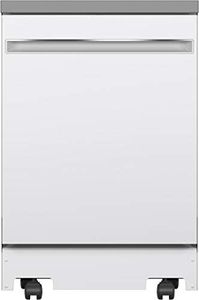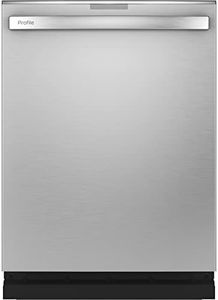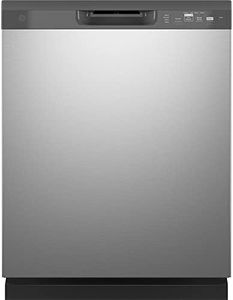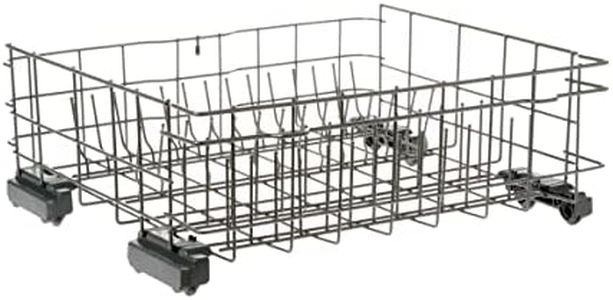4 Best Ge Dishwashers 2025 in the United States
Our technology thoroughly searches through the online shopping world, reviewing hundreds of sites. We then process and analyze this information, updating in real-time to bring you the latest top-rated products. This way, you always get the best and most current options available.

Our Top Picks
Winner
GE GPT225SGLWW 24" Energy Star Fully Integrated Portable Dishwasher with 12 Place Settings Autosense Cycle and Piranha Hard Food Disposer in White
Most important from
8 reviews
The GE GPT225SGLWW is a portable dishwasher that can accommodate up to 12 place settings, making it a solid choice for small to medium households. One of its notable features is the Energy Star certification, which suggests that it operates efficiently and can help save on utility bills. The stainless steel interior is durable and aids in cleaning, while the integrated design offers a sleek look for those with limited space.
In terms of wash performance, the GE GPT225SGLWW includes three wash cycles: Heavy Wash, Light Wash, and Auto Sense. This variety allows you to choose the best setting based on your needs. The Auto Sense feature is particularly useful, as it detects the soil level of your dishes and adjusts the wash accordingly.
Noise level can be an important factor in choosing a dishwasher, and while this model operates quietly for the most part, it may not be the quietest on the market. If you have a very open living space or are sensitive to noise, this could be a drawback. One of the practical features is the Piranha Hard Food Disposer, which helps prevent food debris from clogging the system, ensuring better cleaning performance. While the lack of some smart features might disappoint tech-savvy users looking for advanced connectivity options, the essential performance aspects make it a fitting choice for those who want a straightforward, effective dishwasher without unnecessary complexity.
Most important from
8 reviews
GE Profile PDT785SYNFS 24" Dishwasher with 16 Place Settings WiFi Connnect Twin Turbo Dry Boost Bottle Jets Third Rack Energy Star Certified in Stainless Steel
The GE Profile PDT785SYNFS dishwasher is a solid choice for families or households that require a high-capacity appliance, as it can accommodate up to 16 place settings. This ample capacity ensures that you can clean a large number of dishes in one go, which is a big plus for busy kitchens. One of its standout features is its relatively low noise level of 42 dB, making it a good fit for open-concept living spaces or during nighttime use without disturbing anyone.
In terms of energy efficiency, this model is Energy Star certified, which can help lower your utility bills and is better for the environment. With 11 wash cycles available, you have plenty of options to choose from, depending on the type of load you need to wash. Additionally, the inclusion of a third rack provides extra space for utensils or smaller items, maximizing the use of the interior.
There are some considerations to keep in mind. While many users appreciate its performance, some have noted concerns about the drying efficiency of the dishwasher. Although it features Twin Turbo Dry Boost technology, some dishes may still require manual drying. Moreover, while it does have smart features like WiFi connectivity, those might not be essential for every user, especially if you prefer a simpler appliance.
GE 24 in. Stainless Steel Front Control Tall Tub Dishwasher with Steam Cleaning, Dry Boost, and 59 dBA
The GE 24 in. Stainless Steel Front Control Tall Tub Dishwasher is designed to meet the needs of larger households and those who frequently entertain guests. With a capacity of 12 place settings, it offers ample space for large dishware, making after-gathering cleanups easy. One of its standout features is the Dry Boost technology, which enhances drying performance, ensuring that your items come out drier than what you might expect from other dishwashers. Additionally, it operates at a noise level of 59 dBA, which is relatively quiet, making it suitable for open kitchen layouts.
Energy efficiency is another plus, as this model is Energy Star certified, helping to reduce your electricity bills while being environmentally friendly. The included hard food disposer and leak sensor add valuable conveniences, ensuring reliable performance and reducing the risk of water damage.
There are some aspects to consider before purchasing. The dishwasher has a full-console control panel, which may not be as user-friendly for everyone, especially when compared to simpler designs. While its noise level is quiet, it might not be silent enough for some users who are particularly sensitive to sound. Also, the third rack feature is not mentioned, which could be a drawback for those who prefer more rack organization options. The flush installation feature allows it to integrate well into kitchen designs, but users with limited kitchen space may want to ensure that it fits well with their existing cabinetry. The various wash cycles, including intensive and heated dry options, cater to different cleaning needs, but those looking for smart features may find this model lacking in that area. This dishwasher is well-suited for large households and kitchens with built-in appliance preferences, providing a dependable solution for daily dishwashing tasks.
Buying Guide for the Best Ge Dishwashers
When choosing a GE dishwasher, it's important to consider several key specifications to ensure you select a model that best fits your needs. Dishwashers come with a variety of features and capabilities, and understanding these can help you make an informed decision. Here are some of the most important specs to consider and how to navigate them.FAQ
Most Popular Categories Right Now








